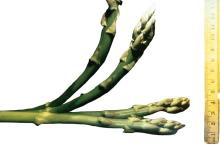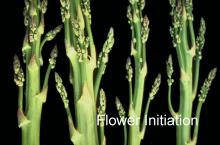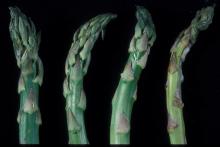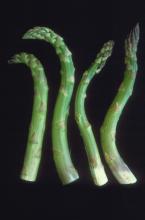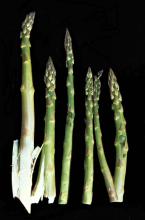Maturity and Quality
Asparagus spears are harvested as they emerge through the soil from the underground crowns. Typically, spears are cut when they reach approximately 23cm (9 in). Stalk diameter is not a good indicator of proper maturity and associated tenderness. (See Quality Indices)
Quality, fresh asparagus will be dark green and firm with tightly closed, compact tips. Stalks are straight, tender and glossy in appearance. U.S. grades are No. 1 and No. 2. California grades range from small (0.47 cm/3/16 in) to Jumbo (2.1 cm/ 13/16) but diameter is not a good indicator of tenderness quality. Washington state standards, XF (Extra Fancy), are being adopted that specify tolerances which are somewhat more stringent than U.S. No. 1.
Postharvest Handling and Storage
0°C-2°C (32°F-35.6°F)
| Temp. °C (°F) |
ml CO2/kg·hr |
| 0 (32) | 14-40 |
| 5 (41) | 28-68 |
| 10 (50) | 45-152 |
| 15 (59) | 80-168 |
| 20 (68 | 138-250 |
| 25 (77) | 250-300 |
To calculate heat production multiply ml CO2/kg·hr by 440 to get Btu/ton/day or by 122 to get kcal/metric ton/day.
Elevated CO2 at 5-10% (typically 7%) in air is beneficial in preventing decay and reducing the rate of toughening of the spears. The beneficial effect is most pronounced if temperatures cannot be maintained below 5°C (41°F). Short (CA) exposure to higher CO2 concentrations (12-20%) is safe and beneficial only if temperatures can be maintained at 0°C-1°C (32°F-33.8°F).
Signs of CO2 injury are small to elongated pits, generally first observed just below the tips. Severe injury results in ribbiness.
95-100%
High relative humidity is essential to prevent dessication and loss of glossiness. Drying of the butt-end of spears is a negative quality factor. Commonly asparagus is packed and shipped in cartons with a water-saturated pad to maintain high humidity.
Exposure to ethylene will accelerate the lignification (toughening) of asparagus spears in controlled studies. The concentration and duration of exposure to exogenous ethylene, to cause this effect, at commonly encountered levels during storage and distribution are not available.
Disorders
- Asparagus will continue to develop after harvest which is why low temperature postharvest management is critical. Common disorders include upward bending of tips away from gravity and "feathering" (expansion and opening) of tips. Bending will also occur if tips expand to the top of the packaging and are deflected
- Spear toughening occurs rapidly at temperatures above 10°C (50°F)
- Bruising and tip-breakage are signs of rough handling and can result in toughening of the spears from wound ethylene
- Asparagus is sensitive to chilling injury after 10 days at 0°C (32°F). Symptoms of chilling injury include loss of sheen or glossiness and graying of the tips. A limp, wilted appearance may be observed. Severe chilling injury may result in darkening near tips in spots or streaks
- Freezing injury (water-soaked appearance leading to extreme softening) will likely result at temperatures of -0.6°C (30.9°F) or lower
The most prominent postharvest disease concern is bacterial soft rot, induced by Erwinia carotovora subsp. carotovora. Decay may initiate at the tips or the butt end. Spears that are re-cut above the white portion of the butt end are reported to be most susceptible to bacterial decay.
Special Considerations
Rapid hydrocooling soon after harvest is strongly recommended. Pyramid-shaped wooden or waxed corrugated boxes for hydrocooling combined with center-loading during shipment promote good cooling-air circulation.




